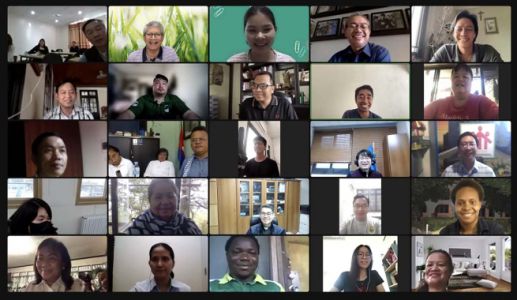【慈幼通訊社 ─ 2022年3月 22日東亞澳區訊】─ 2022年3月17日 星期四,東亞澳區社會傳播培育課程部舉辦第2季的網上課程,題目為「數碼世代的教理講授:從傳播到分享」。課程由慈幼會越南會省 的 Dominic Tran Quang Hien神父帶領,參與者共有 37 名。
Dominic神父分享了四個部分:
- 數碼方式的悔改-數碼世代發生了什麼變化以及我們要作出什麼改變:我們知道數碼世代可以稱為高度式傳播或高度式連繫的時代。因此,教理講授力求創造更多相遇的可能性,使慕道者、傳道員和信仰團體之間的關係更為良好,並同時考慮到現今人類、文化和世界的特性。為此,我們必須理解網絡不只是一種工具,而是一種人際關係的環境。因此,教理講授應該以人為中心,而不是書籍或教義。
- 數碼原住民-教理和學習的新主角:我們認為慕道者是主動者,而非被動者。我們幫助他們建立非自然傾向的重要技能。邀請他們參與、互動、協作並承擔責任。教理講授應該是動態的,使用數碼科技,開展各式各樣的活動,例如祈禱、反省、在 Facebook、Instagram 中分享個人信仰經歷,展開和天主以及和自己一個互動和交流的內在的相遇。
- 網絡神學-在數碼革命中的信仰思想與生活:網絡神學以互聯網作為神學的基地,讓人從不同的社會觀發現重要觀點,建立它的反思。應用梵二大公會議的神學,我們可以將網絡視為「時代徵兆」的神學基地,因為它形成了標誌著當代歷史的偉大現象。因此,教理講授要貼近慕道者的實際境況,回應人們日常生活中的許多問題,如疫症、戰爭、貧窮等,而不是只關注知識或教義的神學。
- 網絡教學法-在互聯網時代中思考教理講授:教理講授應該被視為一個關係網絡,它加強了傳道員與慕道者之間以及慕道者、家庭和社區之間的連繫。教理不應僅僅被理解為內容的指導或傳授,而應被理解為在任何環境中分享在天主內生活的經驗,無論是在線還是離線。有系統地講述耶穌的故事和個人的信仰故事。在假新聞充斥的時代中,我們並非要營造信息的傳遞,而是賦予信息和培育的可信度。這必須以教育者的個人見證、形象和態度為基礎。為此,我們必須從一對多的傳播方式,轉換成多對多的方式,即從傳播理倫走向分享理倫。
在分享結束後,參加者分成六個小組進行討論。他們分享了在每個會省中,於數碼世代進行教理講授時的實況、挑戰和優勢。讓大家了解每位參與者及每個會省的背景,並打開新視野,激發新願景,以及在現今數碼世代進行教理講授的新方法。
Catechesis in the Digital Age
(ANS – East Asia – Oceania, 22 March 2022) – On Thursday, March 17, 2022, the second session for 2022 of the School of Formation for Social Communication Delegates of the Region of East Asia-Oceania was held in digital mode, with the topic: “Catechesis in the Digital Age: From Transmission to Sharing”. It was led by Fr Dominic Tran Quang Hien, SDB, from Vietnam province, and was attended by 37 participants.
Fr Dominic presented the topic in 4 parts:
– Digital metanoia. What changes and what we need to change in the digital era: We recognize that the digital age can be called the era of hypercommunication or hyperconnectivity. So, the catechesis strives to create more possibilities of encounter and more fruitful relationships between the catechumen, the catechist, and the community of faith, considering the characteristics of the human being, culture, and world of today. For this, people must understand the network not as a tool, but as an environment of relationships. Therefore, the catechesis should put the person at the center, not books or doctrine.
– Digital natives. The new protagonists of catechesis and learning: We don’t consider catechumens as passive but active subjects. We help them to develop important skills that are not natural predispositions. To invite them to participate, interact, collaborate, and become responsible. The catechesis should be dynamic, using digital technologies, opening many activities, such as prayer, reflection, sharing personal experiences of faith in Facebook, Instagram and, open an interactive and communicative inner encounter with God and with oneself.
– Cybertheology. Thinking and living the Faith in the middle of a digital revolution: Cybertheology takes the Internet as its locus theologicus from which its different view of society detects the important aspects to develop its reflection. Applying the theology of the Second Vatican Council, we can consider the network a theological place of the “signs of the times,” because it forms a great phenomenon that marks contemporary history. So that the catechesis should be near with the reality of catechumens, respond to many questions of people in their daily lives, such as the pandemic, war, poverty, etc. and not only focus on knowledge or theology of doctrines.
– Network pedagogy. Thinking catechesis in times of the Internet: The catechesis should be thought of as a network of relationships, which nourishes the bonds between catechists and catechumens, and among catechumens, family, and community. Catechesis should not be understood as mere instruction or transmission of content, but as a sharing of the experience of living a life in God in any environment, online or offline. To use a methodology of telling the story of Jesus and the personal story of faith. To form does not mean to transmit information, it means to give credibility to the message and the formation in times of fake news. This must find its base in the personal testimony, image, and attitudes of the educator. For that, we must pass from a one–to–many communication to a many–to–many style, that is, moving from the logic of transmission to the logic of sharing.
A discussion in six groups followed the presentation. They shared about the reality, challenges, and advantages of doing catechesis in the digital age in each province. It helped each participant understand the context of each province and to open a new horizon, inspire a new vision, and a new methodology for doing catechesis in the digital age of today.



